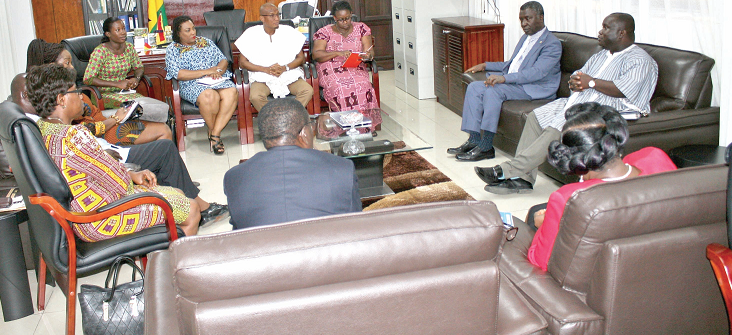
Government’s blueprint for fight against galamsey ready
The government’s blueprint for a sustained fight against illegal mining, popularly known as galamsey, and environmental protection is ready but needs President Nana Addo Dankwa Akufo-Addo’s endorsement before it can be rolled out.
Advertisement
The Minister of Environment, Science, Technology and Innovation, Prof. Kwabena Frimpong-Boateng, made this known when members of the Steering Committee of the Media Coalition Against Galamsey paid a courtesy call on him.
Sketchy details of the plan include using the Marine Police to patrol the country’s major rivers, reviving district mining committees and zoning mining areas where small-scale miners will be allowed to mine under strict supervision.
Additionally, the University of Mines and Technology (UMaT) will be tasked to train about 2,000 people to ensure that good environmental practices are observed in the concessions to be given out to small-scale miners.
The plan
Prof. Frimpong-Boateng, however, declined to disclose the role the security services would play to curtail what had become the country’s number one environmental canker.
The plan also includes the reclamation of hundreds of hectares of land destroyed by illegal miners.
“I have met some of the small-scale miners and they have agreed to fill the trenches,” the minister said.
He said apart from the involvement of traditional rulers, district chief executives (DCEs) and members of Parliament (MPs), the plan would revolve around the involvement of indigenes of mining communities, especially in the reclamation exercise.
The NPP, in its 2016 manifesto, stated that it would annually target 30,000 hectares of degraded areas within and outside forest reserves for reforestation and plantation development, using fast-growing indigenous and exotic species.
Protecting water bodies
With growing public concern over the chemicals used by the miners, Prof. Frimpong-Boateng said the Crops Research Institute of the Council for Scientific and Industrial Research (CSIR) would be tasked to test soils in mining communities to prevent the growing of poisonous foods.
Ghana’s mining laws require that mining companies treat water used for mining activities before it is discharged into the environment, but in the case of illegal miners, water bodies are the centre of their operations, a situation that makes communities living along water bodies vulnerable to the risks of dangerous chemicals.
Communities along the Birim, Pra, Offin and other rivers depend heavily on the water bodies for both domestic and agricultural purposes, a situation that makes them vulnerable.
“In years to come, our fight will not be about electricity. We can solve the power problem with even small hydro dams, but water supply is limited and getting worse,” the minister said.
He commended the media for their fight against galamsey, which he said was yielding results, with the turbidity of some of the water bodies improving.
Alternative livelihood
According to the Ministry of Lands and Natural Resources, statistics from the government’s five-year Multilateral Mining Integrated Project (MMIP), an alternative livelihood programme for illegal miners, indicate that the project will cost $10 million.
Prof. Frimpong-Boateng stated that some mining companies, including Newmont Ghana, had expressed interest in supporting the alternative livelihood programmes.
When the Convener of the coalition, Mr Ken Ashigbey, drew the minister’s attention to seeming contradictions between the ministers of Defence and Lands and Natural Resources on the military’s protection of Russian and Ukrainian miners at a small-scale site in the Ashanti Region, the Environment Minister said the government’s front on the fight against galamsey was not divided.
“The front is tight and not broken. The plans are solid and the President is fully behind us. He has always insisted that we have the mandate of the people to deal with this issue,” he stressed.
Media interest
Earlier, Mr Ashigbey had said that the media were interested in the plan to fight galamsey and that it was important that the fight was sustained.
He expressed satisfaction with the news that there had been some improvement in the turbidity of some water bodies in mining communities but said the danger of pollution was still around, since some of the galamseyers were said to be working on the Bia and the Pra rivers in the night.
He proposed that the Ministry of Health be involved to do an analysis of disease and death patterns in mining communities, while the Ministry of Education could find out what was happening to school enrolment and attendance figures.
The Chairperson of the National Commission on Civic Education (NCCE), Ms Josephine Nkrumah, made a case for the commission to be included in the blueprint to lead the education campaign, as it was on the ground and in touch with the people in all the mining communities.



